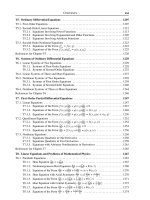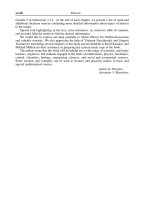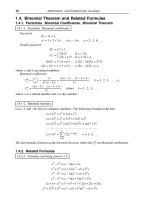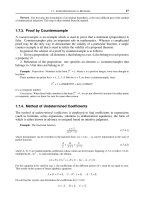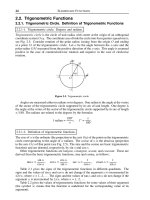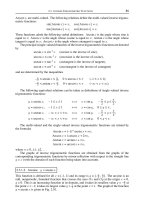Handbook of mathematics for engineers and scienteists part 136 docx
Bạn đang xem bản rút gọn của tài liệu. Xem và tải ngay bản đầy đủ của tài liệu tại đây (371.48 KB, 7 trang )
17.3. LINEAR FUNCTIONAL EQUATIONS 913
homogeneous equation with F(x) ≡ 0, the following three cases are possible (the notation
used here is in agreement with that of Paragraph 17.3.2-1):
(i) Equation (17.3.3.1) on I either has a one-parameter family of continuous solutions
or no solutions at all. If (17.3.3.1) has a continuous solution y
0
(x)onI, then the general
continuous solution on I is given by
y(x)=y
0
(x)+
a
G(x)
,
where a is an arbitrary constant and G(x) is given by (17.3.2.3).
(ii) Equation (17.3.3.1) on I has a continuous solution depending on an arbitrary func-
tion, or has no continuous solutions on I.
(iii) Equation (17.3.3.1) on I either has a continuous solution or no solutions at all.
2
◦
.Letx I, ξ I,andf (x) R
0
ξ
[I]. Suppose that g(x)andF (x) are continuous functions,
g(x) ≠ 0 for x ≠ ξ,andg(ξ)>1. Then equation (17.3.3.1) has a unique continuous solution
that can be represented by the series
y(x)=–
∞
n=0
F (f
[n]
(x))
G
n+1
(x)
,(17.3.3.2)
where the function G
n
(x)isdefined by (17.3.2.2).
17.3.3-2. Equations of special form with g(x)=const.
1
◦
. Consider the equation
y(f(x)) + y(x)=F (x), (17.3.3.3)
which is a special case of equation (17.3.3.1) with g(x)=–1.
(A) Let ξ
I, f (x) R
0
ξ
[I], and suppose that F (x) is a continuous function. If there
exists a continuous solution of equation (17.3.3.3), it can be represented by the power series
y(x)=
1
2
F (ξ)+
∞
n=0
(–1)
n
F (f
[n]
(x)) – F (ξ)
.
(B) Suppose that the assumptions of Item (A) hold and, moreover, there exist positive
constants δ, κ,andC such that
|F (x)–F (ξ)| ≤ C|x – ξ)|
κ
, x (ξ – δ, ξ + δ) ∩I,
and ξ is a strongly attractive fixed point of f(x). Then equation (17.3.3.3) has a continuous
solution on I.
2
◦
. Consider the functional equation
y(f(x)) – λy(x)=F (x), λ ≠ 0.(17.3.3.4)
Let x
I =(a, b]. Assume that on the interval I the function f(x) is continuous, strongly
increasing, and satisfies the condition a < f(x)<x,andF (x) is a function of bounded
variation.
Depending on the value of the parameter λ, the following cases are possible.
914 DIFFERENCE EQUATIONS AND OTHER FUNCTIONAL EQUATIONS
Case |λ| > 1. There is a unique solution
y(x)=–
∞
n=0
F
f
[n]
(x)
λ
n+1
,
which coincides with (17.3.3.2) for g(x)=λ and G
n+1
(x)=λ
n
.
Case 0 < |λ| < 1.Foranyx
0
I and any test function ϕ(z) that has bounded variation
on [f (x
0
), x
0
] and satisfies the condition
ϕ(f(x
0
)) – λϕ(x
0
)=F (x
0
),
there is a single function of bounded variation for which equation (17.3.3.4) holds. This
solution has the same variation on the interval [f (x
0
), x
0
] as the test function ϕ(x).
Case λ = 1. If lim
x→a+0
F (x)=0 and there is a point x
0
I such that the series
∞
n=0
F
f
[n]
(x
0
)
is convergent, then equation (17.3.3.4) has a one-parameter family of
solutions
y(x)=C –
∞
n=0
F
f
[n]
(x)
(here, C is an arbitrary constant), for which there exists a finite limit lim
x→a+0
y(x).
Case λ =–1. See Item 1
◦
.
17.3.3-3. Abel functional equation.
The Abel functional equation has the form
y(f(x)) = y(x)+c, c ≠ 0.(17.3.3.5)
Remark. Without the loss of generality, we can take c = 1 (this can be achieved by passing to the
normalized unknown function ¯y = y/c).
1
◦
.Let¯y(x) be a solution of equation (17.3.3.5). Then the function
y(x)=¯y(x)+Θ
¯y(x)
c
,
where Θ(z) is an arbitrary 1-periodic function, is also a solution of equation (17.3.3.5).
2
◦
. Suppose that the following conditions hold:
(i) f (x) is strictly increasing and continuous for 0 ≤ x ≤ a;
(ii) f (0)=0 and f(x)<x for 0 < x < a;
(iii) the derivative f
(x) exists, has bounded variation on the interval 0 < x < a,and
lim
x→+0
f
(x)=1. Then, for any x, x
0
(0, a], there exists the limit
y(x) = lim
n→∞
f
[n]
(x)–f
[n]
(x
0
)
f
[n–1]
(x
0
)–f
[n]
(x
0
)
,(17.3.3.6)
which defines a monotonically increasing function satisfying the Abel equation (17.3.3.5)
with c =–1 (thisistheL
´
evy solution).
17.3. LINEAR FUNCTIONAL EQUATIONS 915
3
◦
.Letf (x)bedefined on a submodulus interval I and suppose that there is a sequence d
n
for which
lim
n→∞
f
[n+1]
(x)–f
[n]
(x)
d
n
= c, x I.
If for all x
I there exists the limit
y(x) = lim
n→∞
f
[n]
(x)–f
[n]
(x
0
)
d
n
,(17.3.3.7)
where x
0
is an arbitrary fixed point from the interval I, then the function y(x) satisfies
equation (17.3.3.5).
4
◦
. Let us describe a procedure for the construction of monotone solutions of the Abel
equation (17.3.3.5). Assume that the function f(x) is continuous, strictly increasing on the
segment [0, a], and the following conditions hold: f(0)=0 and f (x)<x ≤ a for x ≠ 0.
We define a function ϕ(y)onthesemiaxis[0, ∞)by
ϕ(y)=f
[n]
ϕ
0
({y})
, n =[y], (17.3.3.8)
where [y]and{y} are, respectively, the integer and the fractional parts of y,andϕ
0
(y)is
any continuous strictly decreasing function on [0, 1) such that ϕ
0
(0)=a, ϕ
0
(1 – 0)=f(a).
On the intervals [n, n + 1)(n = 0, 1, ), the function (17.3.3.8) takes the values
ϕ(y)=f
[n]
ϕ
0
(y – n)
, n ≤ y < n + 1,(17.3.3.9)
and therefore is continuous and strictly decreasing, being a superposition of continuous
strictly increasing functions and a continuous strictly decreasing function. At integer
points, too, the function ϕ(y) is continuous, since (17.3.3.8) and (17.3.3.9) imply that
ϕ(n – 0)=f
[n–1]
ϕ
0
(1 – 0)
= f
[n–1]
f(a)
= f
[n]
(a),
ϕ(n)=f
[n]
ϕ
0
(0)
= f
[n]
(a).
Therefore, the function ϕ(y) is also continuous and strictly decreasing on the entire semiaxis
[0, ∞). By continuity, we can define the value ϕ(∞)=0.
It follows that there exists the inverse function ϕ
–1
defined by the relations
x = ϕ(y), y = ϕ
–1
(x)(0 ≤ x ≤ a, 0 ≤ y ≤ ∞), (17.3.3.10)
and ϕ
–1
(0)=∞, ϕ
–1
(a)=0.
From (17.3.3.8), it follows that the function ϕ(y) satisfies the functional equation
ϕ(y + 1)=f
ϕ(y)
, 0 ≤ y < ∞.(17.3.3.11)
Applying ϕ
–1
to both sides of (17.3.3.11) and then passing from y to a new variable x
with the help of (17.3.3.10), we come to the Abel equation (17.3.3.5) with c = 1,where
y(x)=ϕ
–1
(x). Thus, finding a solution of the Abel equation is reduced to the inversion of
the known function (17.3.3.8).
5
◦
. The Abel equation (17.3.3.5) can be reduced to the Schr
¨
odinger–Koenig equation
u(f(x)) = su(x),
with the help of the replacement u(x)=s
y(x)/c
; see equation (17.3.2.5).
916 DIFFERENCE EQUATIONS AND OTHER FUNCTIONAL EQUATIONS
17.3.4. Linear Functional Equations Reducible to Linear Difference
Equations with Constant Coefficients
17.3.4-1. Functional equations with arguments proportional to x.
Consider the linear equation
a
m
y(b
m
x)+a
m–1
y(b
m–1
x)+···+ a
1
y(b
1
x)+a
0
y(b
0
x)=f(x). (17.3.4.1)
The transformation
y(x)=w(z), z =lnx
reduces (17.3.4.1) to a linear difference equation with constant coefficients
a
m
w(z + h
m
)+a
m–1
w(z + h
m–1
)+···+ a
1
w(z + h
1
)+a
0
w(z + h
0
)=f(e
z
), h
k
=lnb
k
.
Note that the homogeneous functional equation (17.3.4.1) with f(x)≡ 0 admits particular
solutions of power type, y(x)=Cx
β
,whereC is an arbitrary constant and β is a root of the
transcendental equation
a
m
b
β
m
+ a
m–1
b
β
m–1
+ ···+ a
1
b
β
1
+ a
0
b
β
0
= 0.
17.3.4-2. Functional equations with powers of x as arguments.
Consider the linear equation
a
m
y
x
n
m
+ a
m–1
y
x
n
m–1
+ ···+ a
1
y
x
n
1
+ a
0
y(x
n
0
)=f (x). (17.3.4.2)
The transformation
y(x)=w(z), z =lnlnx
reduces (17.3.4.2) to a linear difference equation with constant coefficients
a
m
w(z +h
m
)+a
m–1
w(z +h
m–1
)+···+a
1
w(z +h
1
)+a
0
w(z +h
0
)=f(e
e
z
), h
k
=lnlnn
k
.
Note that the homogeneous functional equation (17.3.4.2) admits particular solutions of
the form y(x)=C| ln x|
p
,whereC is an arbitrary constant and p is a root of the transcendental
equation
a
m
|n
m
|
p
+ a
m–1
|n
m–1
|
p
+ ···+ a
1
|n
1
|
p
+ a
0
|n
0
|
p
= 0.
17.3.4-3. Functional equations with exponential functions of x as arguments.
Consider the linear equation
a
m
y
e
λ
m
x
+ a
m–1
y
e
λ
m–1
x
+ ···+ a
1
y
e
λ
1
x
+ a
0
y(e
λ
0
x
)=f (x).
The transformation
y(x)=w(ln z), z =lnx
reduces this equation to a linear difference equation with constant coefficients
a
m
w(z + h
m
)+a
m–1
w(z + h
m–1
)+···+ a
1
w(z + h
1
)+a
0
w(z + h
0
)=f (e
z
), h
k
=lnλ
k
.
17.3. LINEAR FUNCTIONAL EQUATIONS 917
17.3.4-4. Equations containing iterations of the unknown function.
Consider the linear homogeneous equation
a
m
y
[m]
(x)+a
m–1
y
[m–1]
(x)+···+ a
1
y(x)+a
0
x = 0
with successive iterations of the unknown function, y
[2]
(x)=y
y(x)
, , y
[n]
(x)=
y
y
[n–1]
(x)
.
A solution of this equation is sought in the parametric form
x = w(t), y = w(t + 1). (17.3.4.3)
Then the original equation is reduced to the following mth-order linear equation with
constant coefficients (equation of the type (17.2.3.1) with integer differences):
a
m
w(t + m)+a
m–1
w(t + m – 1)+···+ a
1
w(t + 1)+a
0
w(t)=0.
Example. Consider the functional equation
y
y(x)
+ ay(x)+bx = 0.(17.3.4.4)
The transformation (17.3.4.3) reduces this equation to a difference equation of the form (17.2.2.1). Let λ
1
and
λ
2
be distinct real roots of the characteristic equation
λ
2
+ aλ + b = 0,(17.3.4.5)
λ
1
≠ λ
2
. Then the general solution of the functional equation (17.3.4.4) in parametric form can be written as
x = Θ
1
(t)λ
t
1
+ Θ
2
(t)λ
t
2
,
y = Θ
1
(t)λ
t+1
1
+ Θ
2
(t)λ
t+1
2
,
(17.3.4.6)
where Θ
1
(t)andΘ
2
(t) are arbitrary 1-periodic functions, Θ
k
(t)=Θ
k
(t + 1).
Taking Θ
1
(t)=C
1
and Θ
2
(t)=C
2
in (17.3.4.6), where C
1
and C
2
are arbitrary constants, and eliminating
the parameter t, we obtain a particular solution of equation (17.3.4.4) in implicit form:
λ
2
x – y
λ
2
– λ
1
= C
1
λ
1
x – y
C
2
(λ
1
– λ
2
)
γ
, γ =
ln λ
1
ln λ
2
.
17.3.4-5. Babbage equation and involutory functions.
1
◦
. Functions satisfying the Babbage equation
y(y(x)) = x (17.3.4.7)
are called involutory functions.
Equation (17.3.4.7) is a special case of (17.3.4.4) with a = 0, b =–1. The corresponding
characteristic equation (17.3.3.5) has the roots λ
1,2
= 1. The parametric representation of
solution (17.3.4.6) contains the complex quantity (–1)
t
= e
iπt
=cos(πt)+i sin(πt)andis,
therefore, not very convenient.
2
◦
. The following statements hold:
(i) On the interval x (a, b), there is a continuous decreasing solution of equation
(17.3.4.7) depending on an arbitrary function. This solution has the form
y(x)=
ϕ(x)forx
(a, c],
ϕ
–1
(x)forx (c, b),
where c
(a, b) is an arbitrary point, and ϕ(x) is an arbitrary continuous decreasing function
on (a, c] such that
lim
x→a+0
ϕ(x)=b, ϕ(c)=c.
(ii) The only increasing solution of equation (17.3.4.7) has the form y(x) ≡ x.
918 DIFFERENCE EQUATIONS AND OTHER FUNCTIONAL EQUATIONS
3
◦
. Solution in parametric form:
x = Θ
t
2
, y = Θ
t + 1
2
,
where Θ(t)=Θ(t + 1) is an arbitrary periodic function with period 1.
4
◦
. Solution in parametric form (an alternative representation):
x = Θ
1
(t)+Θ
2
(t)sin(πt),
y = Θ
1
(t)–Θ
2
(t)sin(πt),
where Θ
1
(t)andΘ
2
(t) are arbitrary 1-periodic functions, Θ
k
(t)=Θ
k
(t + 1), k = 1, 2.In
this solution, the functions sin(πt) can be replaced by cos(πt).
17.4. Nonlinear Difference and Functional Equations
with a Single Variable
17.4.1. Nonlinear Difference Equations with a Single Variable
17.4.1-1. Riccati difference equation.
The Riccati difference equation has the general form
y(x)y(x + 1)=a(x)y(x + 1)+b(x)y(x)+c(x), (17.4.1.1)
where the functions a(x), b(x), c(x) satisfy the condition a(x)b(x)+c(x)
0.
1
◦
. The substitution
y(x)=
u(x + 1)
u(x)
+ a(x)
reduces the Riccati equation to the linear second-order difference equation
u(x + 2)+[a(x + 1)–b(x)]u(x + 1)–[a(x)b(x)+c(x)]u(x)=0.
2
◦
.Lety
0
(x) be a particular solution of equation (17.4.1.1). Then the substitution
z(x)=
1
y(x)–y
0
(x)
reduces equation (17.4.1.1) to the first-order linear nonhomogeneous difference equation
z(x + 1)+
[y
0
(x)–a(x)]
2
a(x)b(x)+c(x)
z(x)+
y
0
(x)–a(x)
a(x)b(x)+c(x)
= 0.
17.4.1-2. First-order nonlinear difference equations with no explicit dependence on x.
Consider the nonlinear functional equation
y(x + 1)=f
y(x)
, 0 ≤ x < ∞ ,(17.4.1.2)
where f(y) is a continuous function.
Let y(x)beafunctiondefinedonthesemiaxis[0, ∞)by
y(x)=f
[n]
ϕ({x})
, n =[x], (17.4.1.3)
where [x]and{x} are, respectively, the integer and the fractional parts of x,andϕ(x)isany
continuous function on [0, 1) such that ϕ(0)=a, ϕ(1 – 0)=f (a), a is an arbitrary constant.
Direct verification shows that the function (17.4.1.3) satisfies equation (17.4.1.2) and is
continuous on the semiaxis [0, ∞).
17.4. NONLINEAR DIFFERENCE AND FUNCTIONAL EQUATIONS WITH A SINGLE VARIABLE 919
17.4.1-3. Nonlinear mth-order difference equations.
1
◦
. In the general case, a nonlinear difference equation has the form
F
x, y(x + h
0
), y(x + h
1
), , y(x + h
m
)
= 0.(17.4.1.4)
This equation contains the unknown function with different values of its argument differing
from one another by constants. The constants h
0
, h
1
, , h
m
are called differences or
deviations of the argument. If all h
k
are integers, then (17.4.1.4) is called an equation with
integer differences. If h
k
= k (k = 0, 1, , m) and the equation explicitly involves y(x)
and y(x + m), then it is called a difference equation of order m.
2
◦
.Anmth-order difference equation resolved with respect to the leading term y(x + m)
has the form
y(x + m)=f
x, y(x), y(x + 1), , y(x + m – 1)
.(17.4.1.5)
The Cauchy problem for this equation consists of finding its solution with a given initial
distribution of the unknown function on the interval 0 ≤ x ≤ m:
y = ϕ(x)at0 ≤ x ≤ m.(17.4.1.6)
The values of y(x)form ≤ x ≤ m + 1 are calculated by substituting the initial values
(17.4.1.6) into the right-hand side of equation (17.4.1.5) for 0 ≤ x ≤ 1.Wehave
y(x + m)=f
x, ϕ(x), ϕ(x + 1), , ϕ(x + m – 1)
.(17.4.1.7)
Then, replacing x by x + 1 in equation (17.4.1.5), we obtain
y(x + m + 1)=f
x + 1, y(x + 1), y(x + 2), , y(x + m)
.(17.4.1.8)
The values of y(x)form + 1 ≤ x ≤ m +2 are determined by the right-hand side of (17.4.1.8)
for 0 ≤ x
≤ 1, the quantities y(x+1), , y(x +m–1) are determined by the initial condition
(17.4.1.6), and y(x + m) is taken from (17.4.1.7).
In order to find y(x)form + 2 ≤ x ≤ m + 3, we replace x by x + 1 in equation (17.4.1.8)
and consider this equation on the interval 0 ≤ x ≤ 1. Using the initial conditions for y(x + 2),
, y(x + m – 1) and the quantities y(x + m), y(x + m + 1) found on the previous steps, we
find y(x + m + 2).
In a similar way, one can find y(
x)form + 3 ≤ x ≤ m + 4, etc. This method for solving
difference equations is called the step method.
17.4.2. Reciprocal (Cyclic) Functional Equations
17.4.2-1. Reciprocal functional equations depending on y(x)andy(a – x).
1
◦
. Consider a reciprocal equation of the form
F
x, y(x), y(a – x)
= 0.
Replacing x by a – x, we obtain a similar equation containing the unknown function
with the same arguments:
F
a – x, y(a – x), y(x)
= 0.
Eliminating y(a – x) from this equation and the original equation, we come to the usual
algebraic (or transcendental) equation of the form Ψ
x, y(x)
= 0.
In other words, solutions of the original functional equation y = y(x)aredefined in a
parametric manner by means of two algebraic (or transcendental) equations:
F (x, y,t)=0, F (a – x, t, y)=0,(17.
4.2.1)
where t is a parameter.



